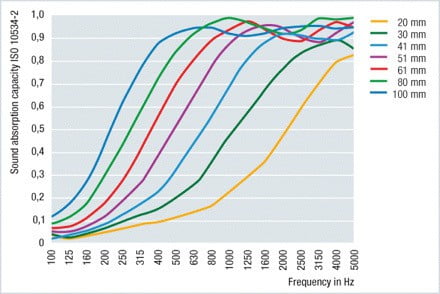When it comes to soundproofing, selecting the right foam material is crucial for achieving optimal results. Different foams offer varying advantages, each catering to specific soundproofing applications.
In this article, we will delve into the benefits of various foams commonly used for soundproofing, including Melamine Foam, PVC Nitrile Foam, PE Foam, Polyurethane Foam, Impregnated PU Foam, and Felted Foam. Additionally, we will explore the advantages of soundproofing in various settings, such as wall tiles, ceiling tiles, suspended baffles, floor underlay, microphone windshields/booms, underfloor shock absorbers, speaker grilles, ear defenders/pads, generator housings, and HVAC systems.
Foam Materials for Soundproofing Applications:
Melamine Foam
Melamine foam, also known as Basotect or acoustic foam, is an excellent choice for soundproofing applications due to its open-cell structure. Advantages include:
- Excellent sound absorption properties.
- Lightweight and easy to install.
- Resistant to high temperatures and fire.
- Provides thermal insulation
PVC Nitrile Foam
PVC Nitrile foam, often referred to as rubber foam, is a versatile material suitable for various soundproofing needs. Key advantages include:
- Good acoustic insulation.
- High resistance to water, oil, and chemicals.
- Flexible and durable.
- Excellent thermal insulation properties.
PE Foam
PE (Polyethylene) foam is a lightweight and cost-effective solution for soundproofing. Its advantages include:
- Good sound absorption capabilities.
- Easy to handle, cut, and install.
- Resistant to moisture and chemicals.
- Offers thermal insulation.
Polyurethane Foam
Polyurethane foam, commonly used in acoustic panels, provides reliable soundproofing benefits. Key advantages include:
- Excellent sound absorption properties.
- Highly versatile and available in various densities and thicknesses.
- Durable and long-lasting.
- Resistant to moisture and mildew.
Impregnated PU Foam
Impregnated polyurethane (PU) foam is specifically designed for enhanced soundproofing performance. Advantages include:
- Superior sound absorption capabilities.
- Enhanced fire resistance.
- Excellent resistance to water, oil, and chemicals.
- Ideal for demanding soundproofing applications.
Felted Foam
Felted foam, typically made from polyester fibers, offers unique soundproofing advantages. Key benefits include:
- Good sound absorption properties.
- Flexible and easy to work with.
- Provides thermal insulation.
- Resistant to moisture and mold.
Benefits of Soundproofing in Various Applications
There are a number of purposes and applications which soundproofing benefits in many ways. The most common uses for foam soundproof
- Wall Tiles:
- Reduce noise transmission between rooms.
- Enhance privacy and comfort.
- Improve acoustics within a space.
- Ceiling Tiles:
- Minimize airborne sound transmission.
- Control reverberation and echoes.
- Enhance speech intelligibility.
- Suspended Baffles:
- Absorb sound and reduce reflections.
- Enhance speech clarity.
- Create a more controlled acoustic environment.
- Floor Underlay:
- Reduce impact noise and footfall sound.
- Provide thermal insulation.
- Improve overall comfort.
- Microphone Windshields/Booms:
- Minimize wind noise during audio recordings.
- Improve clarity and reduce unwanted vibrations.
- Shield microphones from unwanted background noise.
- Underfloor Shock Absorbers:
- Minimize vibrations and impact noise.
- Protect sensitive equipment or structures from vibrations.
- Increase comfort and reduce structural damage.
- Speaker Grilles:
- Reduce unwanted resonance and vibration.
- Improve sound quality and clarity.
- Protect speakers from dust and damage.
- Ear Defenders/Pads:
- Block or reduce external noise levels.
- Protect hearing from excessive noise exposure.
- Enhance concentration and safety in noisy environments.
- Generator Housings:
- Reduce noise emissions from generators.
- Maintain a quieter environment in residential or commercial areas.
- Comply with noise regulations and standards.
- HVAC Systems:
- Minimize noise generated by HVAC units.
- Enhance comfort by reducing unwanted noise.
- Maintain a quieter environment in residential, commercial, or industrial spaces.
Selecting the right foam material is essential for effective soundproofing in various applications. Melamine foam, PVC Nitrile foam, PE foam, polyurethane foam, impregnated PU foam, and felted foam each offer unique advantages, catering to different soundproofing needs. Additionally, soundproofing offers a multitude of benefits in applications such as wall tiles, ceiling tiles, suspended baffles, floor underlay, microphone windshields/booms, underfloor shock absorbers, speaker grilles, ear defenders/pads, generator housings, and HVAC systems. By understanding these advantages, one can make informed decisions when choosing the appropriate foam material and soundproofing solution for specific requirements.

